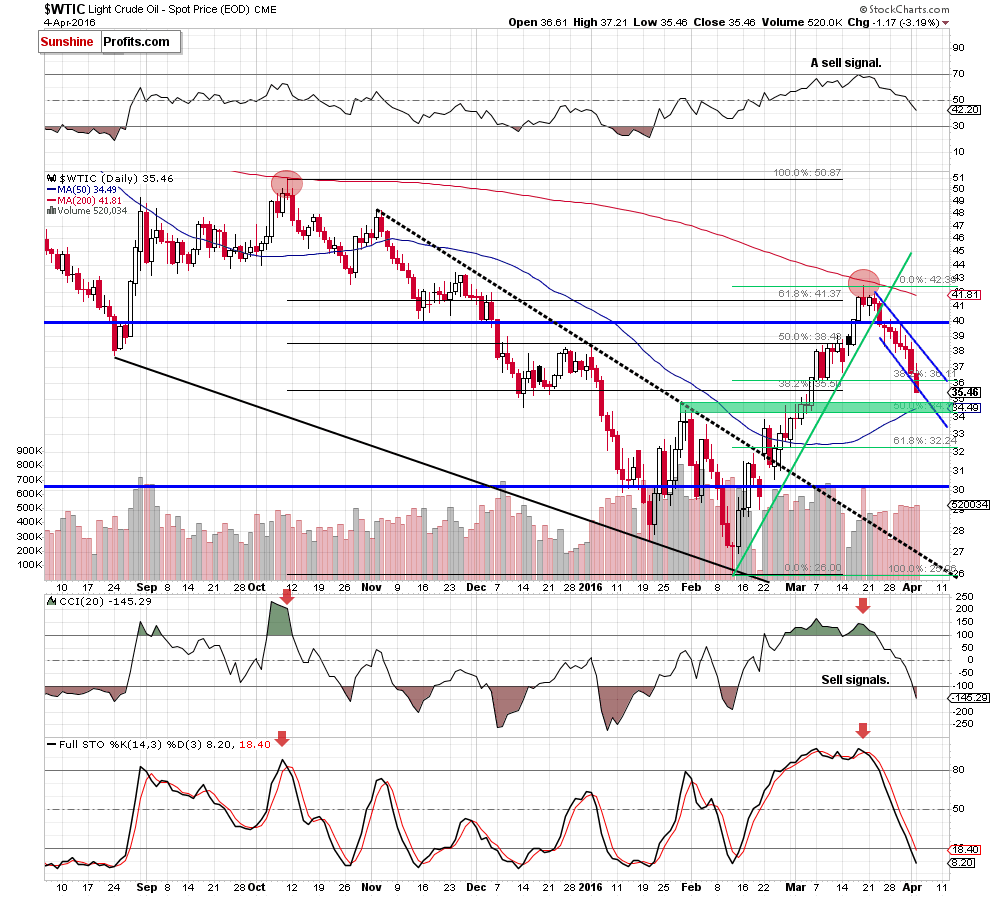Trading position (short-term; our opinion): No positions are justified from the risk/reward perspective.
On Monday, crude oil moved lower once again as the combination of uncertainty around a production freeze deal and another increase in Russian oil production affected negatively investors’ sentiment. Thanks to these circumstances, light crude slipped under the Fibonacci retracement and closed the day below $36. Will oil bears manage to push the commodity lower in the coming days?
Yesterday, Russia reported that its oil production rose to 10.91M bbl per day in the previous month (up 0.3% from Feb), which was the highest level since 1987 when the country produced 11.5M bbl per day. This news, in combination with Saudi Arabia comments that the country would freeze production only if Iran did the same increased doubts about the ability of the largest oil exporters to reach an agreement when they meet in Doha next week. As a result, light crude slipped under important support zone and closed the day below $36. Will oil bears manage to push the commodity lower in the coming days? Let’s examine charts and try to answer this question (charts courtesy of http://stockcharts.com).

Looking at the daily chart, we see that crude oil extended losses and declined below the 38.2% Fibonacci retracement (based on the Feb-March upward move) and bottoms of the previous pullbacks. With this move, the commodity also slipped under the lower border of the blue declining trend channel, which suggests that light crude will likely test the strength of the next support zone created by the Jan and late-Feb highs, the 50% Fibonacci retracement and the 50-day moving average in the coming days.
Nevertheless, taking into account the current position of the CCI and Stochastic Oscillator, it seems that the space for declines may be limited and reversal in the coming week can’t be ruled out. If this is the case, and light crude rebounds from here, we may see a increase to around $38, where the upper line of the blue declining trend channel currently is. However, such price action would be more reliable, if the commodity invalidates yesterday’s small breakdown under the lower border of the formation.
Summing up, crude oil closed yesterday’s session under the 38.2% Fibonacci retracement and slightly below the lower line of the blue declining trend channel, which suggests a test of the next support zone in the coming day(s).
Very short-term outlook: mixed
Short-term outlook: mixed
MT outlook: mixed
LT outlook: mixed
Trading position (short-term; our opinion): No positions are justified from the risk/reward perspective. We will keep you – our subscribers – informed should anything change.
As a reminder – “initial target price” means exactly that – an “initial” one, it’s not a price level at which we suggest closing positions. If this becomes the case (like it did in the previous trade) we will refer to these levels as levels of exit orders (exactly as we’ve done previously). Stop-loss levels, however, are naturally not “initial”, but something that, in our opinion, might be entered as an order.
Since it is impossible to synchronize target prices and stop-loss levels for all the ETFs and ETNs with the main market that we provide this level for (crude oil), the stop-loss level and target price for popular ETN and ETF (among other: USO, DWTI, UWTI) are provided as supplementary, and not as “final”. This means that if a stop-loss or a target level is reached for any of the “additional instruments” (DWTI for instance), but not for the “main instrument” (crude oil in this case), we will view positions in both crude oil and DWTI as still open and the stop-loss for DWTI would have to be moved lower. On the other hand, if crude oil moves to a stop-loss level but DWTI doesn’t, then we will view both positions (in crude oil and DWTI) as closed. In other words, since it’s not possible to be 100% certain that each related instrument moves to a given level when the underlying instrument does, we can’t provide levels that would be binding. The levels that we do provide are our best estimate of the levels that will correspond to the levels in the underlying assets, but it will be the underlying assets that one will need to focus on regarding the sings pointing to closing a given position or keeping it open. We might adjust the levels in the “additional instruments” without adjusting the levels in the “main instruments”, which will simply mean that we have improved our estimation of these levels, not that we changed our outlook on the markets.
Thank you.
Nadia Simmons
Forex & Oil Trading Strategist
Przemyslaw Radomski, CFA
Founder, Editor-in-chief
Gold & Silver Trading Alerts
Forex Trading Alerts
Oil Investment Updates
Oil Trading Alerts



